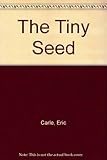Lesson 1: Visual and Meaning Cues
Lesson Plan
The Tiny Seed (Big Book) | 400L

- Learning Goal
- Use visual cues to read unknown words.
- Use meaning cues to read unknown words.
- Duration
- Approximately 50 minutes
- Necessary Materials
- Provided: Assessment
Not Provided: The Tiny Seed by Eric Carle
-
Teacher Modeling

will explain that when we do not know a word while reading, we can think about what word would make sense in the sentence (meaning) and look at the letters in the word to help us identify the word (visual). I will use The Tiny Seed by Eric Carle (big book) to model how to use visual and meaning cues to decode unknown words. I will model substituting the word “fall” for “autumn” (visual) on page 1. I will stop and think aloud: "The picture on this page shows trees with leaves of all different colors. I know that leaves change colors in the fall. I think it is 'fall'. But if I look at the letters in the word, that doesn’t make sense. I know that 'fall' starts with 'f' and this word starts with an 'a'. Another word for 'fall' that starts with an 'a' is 'autumn'. I think this word is 'autumn'. I know this because I thought about whether it made sense in the sentence and if the letters looked right." I will substitute "bun" for "burn" (meaning) on page 3 and think aloud about how that doesn’t make any sense. This word looks like the word "bun". I will read the sentence again and see if that makes sense. “'The sun’s hot rays bun it up.' That doesn’t make any sense. It must be another word that starts with “bu–”. I know the sun is very hot and the sun’s rays can burn. I think the word is burn because that makes sense in the sentence and the word looks like 'burn'." I will continue to model these cueing systems by substituting “ice” for “icy” (meaning) on page 6 and “small” for “tiny” (visual) on page 6.
-
Think Check
Ask: "How did I figure out words in the text that I did not know?" Students should respond that you looked at the letters in the word and thought about what word has those letters and would make sense in the sentence.
-
Guided Practice

will listen for any visual and meaning errors as the teacher reads the rest of the book aloud. The teacher will substitute “downs” for “drowns” (meaning) on page 9, “dessert” for “desert” (meaning) on page 10, “flies” for “comes” (visual) on page 12, and “ground” for “earth” (visual) on page 15. We will stop reading at page 15 and discuss how thinking about which words made sense and looking at the letters of the word helped us read the beginning of the book. Note: The remainder of the book will be read in Lesson 2. An assessment is provided.
TIP: When students correctly determine the meaning of a word, have them discuss why they are correct. Have students explain which visual and meaning cues they used to determine the meaning of the unknown word.
-
Independent Practice

will use visual and meaning cues to decode unknown words in independent and guided reading. The teacher will assess these strategies using the attached recording form.
Texts & Materials
Standards Alignment
(To see all of the ReadWorks lessons aligned to your standards, click here.)

